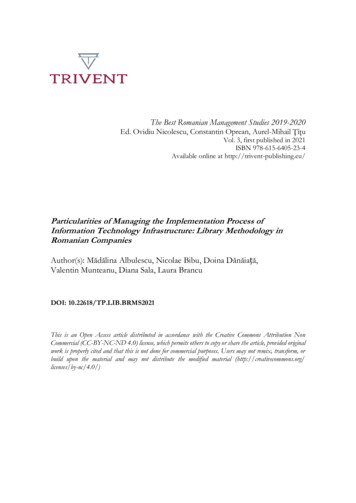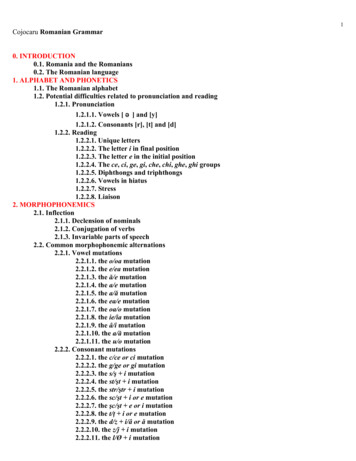
Transcription
The Best Romanian Management Studies 2019-2020Ed. Ovidiu Nicolescu, Constantin Oprean, Aurel-Mihail ŢîţuVol. 3, first published in 2021ISBN 978-615-6405-23-4Available online at http://trivent-publishing.eu/Particularities of Managing the Implementation Process ofInformation Technology Infrastructure: Library Methodology inRomanian CompaniesAuthor(s): Mădălina Albulescu, Nicolae Bibu, Doina Dănăiață,Valentin Munteanu, Diana Sala, Laura BrancuDOI: 10.22618/TP.LIB.BRMS2021This is an Open Access article distributed in accordance with the Creative Commons Attribution NonCommercial (CC-BY-NC-ND 4.0) license, which permits others to copy or share the article, provided originalwork is properly cited and that this is not done for commercial purposes. Users may not remix, transform, orbuild upon the material and may not distribute the modified material (http://creativecommons.org/licenses/by-nc/4.0/)
Particularities of Managing the Implementation Process ofInformation Technology Infrastructure:Library Methodology in Romanian CompaniesMădălina Albulescu 11West University of Timisoara, Romania, mada.albulescu@gmail.comNicolae Bibu22West University of Timisoara, Romania, nicolae.bibu@e-uvt.roDoina Dănăiață33West University of Timisoara, Romania, doina.danaiata@e-uvt.roValentin Munteanu44West University of Timisoara, Romania, valentin.munteanu@e-uvt.roDiana Sala55West University of Timisoara, Romania, diana.sala@e-uvt.roLaura Brancu66West University of Timisoara, Romania, laura.brancu@e-uvt.roIntroductionToday, companies are increasingly demanding information managementtechnologies in order to provide quality services for both internal and externalcustomers. As such, organizations are dependent on IT services and expectations ofthese services are related to both supporting internal processes and bringingimprovements within the company.In this context, the IT Infrastructure Library (ITIL) is probably the moststructured approach to facilitate the delivery of IT services.1 The ITIL methodologyis globally recognized as a set of practices for IT Service Management inorganizations and considered the most applicable methodology in all categories ofcompanies in the world.2 In its current form (known as ITIL 2011), the ITILmethodology is published as a five-volume series, each covering a different stage ofthe IT Service Managemenet (ITSM) life cycle. Although ITIL supports ISO / IEC20000 (formerly BS 15000), the international service management standard for ITservice management, there are some differences between the ISO 20000 standardJantti H. and Virpi H., “Defining the relationships between IT service management and IT servicegovernance,” Springer Science Business Media (2015).2 itSMF, Welcome to itSMF International (2016). Accessed on: www.itsmfi.org.1
Mădălina Albulescu et al.and the ITIL framework.3 ITIL describes processes, procedures, tasks, andchecklists that are not organization-specific but can be applied by an organizationto establish integration with the organization's strategy, provide value, and maintaina minimum level of expertise.4Pollard & Cater-Steel5 describe the ITIL methodology as “a set of publicationsthat guide towards a good management of IT processes, functions andresponsibilities of service provision within a company.” Iden and Langeland6 arguethat there is still no company that has implemented all ITIL processes andfunctions. This is because there is no general rule that requires the adoption of allprocesses and functions of the methodology. ITIL allows its adaptation accordingto the needs and strategy of the company.The study analyzes the entire process of implementing the ITIL methodology incompanies from different fields of activity in Romania. The points of interest of thestudy include identifying the factors that lead to the need to implement ITIL, thechallenges encountered during the implementation process, the changemanagement model applied for this process and a highlight of the factors thatcontribute to the success or failure of ITIL implementation. As a result, in thispaper the notions of “ITIL implementation” and “ITIL adoption” do not refer tothe implementation of the methodology in full form. These terms will be used inthis study to describe the activities pursued by different companies to addressdifferent processes or functions of the ITIL methodology.What are the factors that lead to the need to implement the ITIL methodologyin a company? The first research question develops an understanding of the factorsthat lead to the need to implement the ITIL methodology. There are a multitude ofproblematic situations that require their solution by making this major change.What are the challenges encountered during the ITIL implementation process?The second question refers to the ITIL implementation process. It is interesting toknow what challenges are faced by organizations throughout the process and howthey are addressed so that they can be overcome as quickly and easily as possible.What is the change management model (CMM) used for the implementation ofITIL? The specialized literature offers several change management models such asthe Kotter’s eight steps model, the Lewin model, the 7S model of McKinsey, theAdkar model, the PDCA model, the Kubler-Ross model of change that help anychange to be made as organized as possible, with maximum results. The thirdquestion in the research paper is whether there is a CMM used by companies in theimplementation process and if so, what would it be.What are the factors that contribute to the success / failure of the ITILLimanto A., Rumagit R., Pietono V., Halim Y., “Study of Information Technology InfrastructureLibrary (ITIL) framework implementation at the various business field in Indonesia,” 5th InternationalConference on Cyber and IT Service Management (CITSM) (2017).4 OGC, ITIL Service Support, The Stationary Office (2010).5 Pollard C., Cater-Steel A., “Justifications, Strategies, and Critical Success Factors in Successful ITILImplementations in U.S. and Australian Companies: An Exploratory Study,” Information SystemsManagement 26 (2009): 164-175.6 Iden J., Langeland L., “Setting the Stage for a Successful ITIL Adoption: A Delphy Study of ITExperts in the Norwegian Armed Forces,” Information Systems Management (2010).316
Particularities of Managing the Implementation Process of Information Technology Infrastructureimplementation? Like any change, the implementation of ITIL can be positively ornegatively influenced by different factors. The last research question aims to findout which are the factors that contribute to a successful implementation or that canlead to a failure of the whole process, including the involvement of topmanagement in implementing the change plan for ITIL implementation.7The research methodology is qualitative, using the case study method. Followinga complex selection process of potentially interesting companies for research, usingcriteria such as: to be active in Romania, to have partially or totally implementedITIL methodology, to be from various fields of activity, to be of a medium size,with at least 51 employees, finally, five companies were chosen.The data underlying the research were obtained by completing questionnairesaddressed to managers involved in the ITIL implementation process as well as byconducting detailed interviews with members of the implementation team. Theinformation was also collected from various written documents made available toresearchers, as well as from the companies' intranet, regarding the ITILimplementation process. During the research, a collective and comparative analysisof the information obtained was performed, which provided an overview of theresults of each phase of the process, presented in parallel for the companiesinvolved.Analysis of the dataThe 5 companies that were the object of the research differ both in size (number ofemployees) and in the field in which they operate. One company operates in theretail field, three operate in the IT field and one company in the automotive field.Of the five cases, four are more than 10 years old on the market, which indicates amaturity of market presence and the one operating in the automotive field isbetween 1-5 years old. The size of the companies differs, two being in the range of500-2000 employees, one being in the range of 100-500 employees and two haveover 2000 employees. Two of the five companies are nationally active, and theother three are subsidiaries of multinational companies.Company A is a national company with activity in the retail field, having a largenumber of stores throughout the country. Company B is a multinational company,active in the IT field, which has been offering IT services to customers for over 10years, with an emphasis on the subdomain of networking. It employs between 500and 2000 employees. Company C is also a multinational IT company, with the sameseniority on the market as company B, but with a larger number of employees: over2000. The company provides support for various IT operations to its customers.Company D is a company with over 10 years of experience, operating in the ITfield that offers IT support services for both hardware and software. It is a nationalcompany, employing between 100-500 employees. Case E is a multinational withactivity in the automotive field, a company formed following a detachment fromIden J., Eikebrokk T., “The Impact of Senior Management Involvement, OrganisationalCommitment and Group Efficacy on ITIL Implementation Benefits,” Information Systems & e-BusinessManagement (2015).717
Mădălina Albulescu et al.another larger company, being active on the market for less than 5 years, andemploying between 500-2000 employees.We wanted to study companies that operate in different fields and havedifferent numbers of employees to create a more varied picture of the ITILimplementation process in different contexts and with different resources. It wasthus possible to collect data from companies covering four of the five options thatrefer to the number of employees, with the exception of the answer option "lessthan 50 employees". No company with less than 50 employees took part in our casestudy, because we did not find such a company implementing ITIL methodology.Table 1, below, summarizes all the information mentioned above.Table 1. The characteristics of the studied companiesCompanyLevel ofactivityField ofactivityActive in the marketNumber NationalMultinationalRetailITITITAutomotiveover 10 yearsover 10 yearsover 10 yearsover 10 yearsbetween 1-5 yearsMore than 2000between 500-2000More than 2000Between 100-500Between 500-2000Table 2. The implementation period of ITIL in each companyCompanyABCDEThe beginning date for ITILimplementationThe end date for .12.2017-01.01.200701.06.201401.01.2019In all companies, the answers to the questionnaire were provided by employeeswho had or still have a direct connection with the process of implementing theITIL methodology within the companies in which they operate. Participating in thestudy were an IT director, a Service Management team coordinator, a Project &Operations Manager, an operational director and an IT services manager. Eachperson had knowledge both about the pre-implementation period and about theimplementation period and the current stage, being employed in the companies forthe entire time covered by the structure of the questionnaire. The period ofimplementation of the ITIL methodology differ from one company to another, 1company starting in 2007, 1 in 2014, 1 company in 2016, 1 in 2017 and 1 in 2019.The period in which this change took place varies from case to case. Company Bimplemented the ITIL methodology within less than a year, while Company Dcompleted the implementation of ITIL in 3 and a half years. The following tableshows the cases with the start date of the ITIL methodology’s implementation and18
Particularities of Managing the Implementation Process of Information Technology Infrastructurethe responses received for the end date of the process. The end period of ITILimplementation was not provided for all cases. For cases A and C no completiondate was set, and for case E, the implementation of ITIL was still ongoing at thetime of the investigation.The pre-implementation period of the ITIL methodologyAlthough the five companies studied started implementing the ITIL methodologybeing in different stages and having different visions on the process that was totake place, their main points of interest are remarkably similar. For 4 companies (A;C; D and E) the delivery of term services is the main reason for the implementationof ITIL of companies. All four mentioned this activity as important. Companies Dand E mentioned as additional objectives the traceability of employeeresponsibilities and projects. Service delivery time is one of the factors that leads topositive feedback from customers and was mentioned in companies A, D and E. Inaddition, the continuity and availability of applications (case A), IT development inline with the company's strategy (case A) and increase the quality of technicalsupport (case D) were also mentioned.As mentioned above, each investigated company started the ITILimplementation process in different stages of development. In four out of fivecases (A, C, D and E), however, there was at least one ITIL process alreadyimplemented, which either needed changes or was not followed properly enough.Only one company (B) had no ITIL process or function implemented at the timethe change started. The most common process already implemented, present in theremaining four cases is the Incident Management process. It is found in all fourcompanies (cases A, C, D, E), for cases A and C being the only process or functionaddressed so far. Also, all companies had a database and a program for recordingand managing incidents. In cases D and E, in addition to the Incident Managementprocess, the Service Desk function was also functional, either under this name orunder the name HelpDesk. The table below presents a picture of the cases togetherwith the ITIL processes / functions for each of them.Table 3. The ITIL processes implemented in each company during the preimplementation periodCompanyABCDEProcesses/functions during theITIL pre-implementation periodIncident ManagementIncident ManagementIncident Management Service DeskIncident ManagementRegarding the identification of the main problems that led to the idea ofimplementing the ITIL methodology, we identified that the main cause was theneed for clearer structuring of different types of cases, requirements and problems19
Mădălina Albulescu et al.that customers and users had, leading to negative feedback from them. A problemoften encountered and reported by companies is the non-compliance with theterms agreed with the client regarding the delivery of services, provided in theconcluded Service Level Agreement (SLA).In four out of five cases, the implementation of the IITL methodology was aproactive action, and only one company considers this change to be reactive. Allcompanies consider that the whole process is part of strategic planning.Regarding the involvement of third parties in the process of implementing themethodology in 4 companies, no consulting firm or other third party was used.Only company D turned to a consulting firm, considering a safer way to implementthe ITIL methodology.Regarding the change management model used for the process of implementingthe ITIL methodology to companies, we concluded that two companies followed achange model for the implementation of ITIL, while three chose to make thischange without following any change model, mainly due to lack of knowledge inthe field. In all five cases, the change process was initiated by the company's Boardof Directors, an action that required the involvement of many departments andmany resources over time. Out of a total of five companies participating in theresearch, three of them (B, D, and E, 60%) approached the implementation of theITIL methodology without resorting to change theory and without addressing anychange management model. Companies B, D and E followed this process withinternal teams, consisting of either team leaders or employees with experience inthe company, developed a project with steps to follow and implemented the ITILmethodology respecting the stages of the internally established process.In the case of company E, the implementation of ITIL did not require a changemanagement model approach due to the fact that change was estimated to be aneasy process, since the ITIL methodology was already largely known into thecompany. Consequently, the approach was estimated by the top management of thecompany as an easy change.Instead, the other two companies participating in the case study opted to use achange management model. Surprisingly, both company A and company C chosethe PDCA model to follow in the case of implementing the ITIL methodology.However, the approach was different in the two cases. Company A implementedthe ITIL methodology with internal resources, having a team specially trained forchange.It is interesting to find out which were the processes and functions selected bythe companies for implementation. Thus, Incident Management, ProblemManagement, Change Management and Service Desk processes were selected by allorganizations at the beginning of the ITIL implementation. Although all companiesinitially had both the Incident Management process and the Service Desk functionfunctional in one way or another, they were selected either for their correction orfor a re-implementation with ITIL recommendations. Companies B, C and Eselected the Service Level Management process (60%). Two out of five companies(A and B) chose the Release Management, Capacity Management and AccessManagement processes (40%). With a percentage of 20%, being selected only by20
Particularities of Managing the Implementation Process of Information Technology Infrastructureone company were the processes Configuration Management, IT FinancialManagement, Availability Management, IT Service Continuity Management. In thecase of company C, the need to add new implementation processes arose duringthe delivery of services to customers. Thus, over time there have been changes tothe initial planning, with some processes either being removed from the lists orothers added.Table 4 below presents the processes and functions selected for ITILimplementation in each of the participating companies.Table 4. Processes and functions selected for implementation in each nagementCompanyACompany Company Company CompanyBCDEConfigurationManagementChange ManagementRelease ManagementService DeskService LevelManagementIT anagementIT Service ContinuityManagementAccess ManagementOf all the processes and functions selected for implementation, the IncidentManagement and Change Management processes were the first to be addressed forchange by all five companies participating in the study. The Service Desk functionwas chosen by four of the five companies, and the Problem Management processby two out of five. In the case of company A, were chosen processes referring tothe technical support area and Devops, understanding here the processes that are21
Mădălina Albulescu et al.related to a better functioning of the operations within the company.The technical support teams were the first teams involved in organizationalchange in all five cases. Companies A and E also mentioned the ProjectManagement department, and company E also mentioned the HR department,being about creating new roles and the need for new employees. The IT servicesmanager mentions that in the case of company A, all the teams in the organizationwere impacted, starting from the Service Desk to the Management team of thecompany. In 80% of the cases studied, we identified some organizational changessuch as creation of new teams, changes of positions, creation of new roles, etc.Company B answered negatively to this question, the implementation of ITIL beingsuccessful without too many changes in resources. Instead, cases C, D and E aresimilar in this respect: in all three cases new roles have been created such as the roleof Change Manager, Incident Manager. Companies D and E have changed thename of the technical support team manager to ServiceDesk Manager. In case A,the entire IT department was segmented by the types of services delivered. It issimilar to case D, where different technical teams were also created, depending onthe difficulty of the topics and problems addressed: support level 1, support level 2and support level 3. The following table summarizes the changes for each company.Table 5. Changes done in each companyCompanyABCOrganizational changesSegmentation of the IT departamentCreating new teams: IT Support, IT Development, IT Reporting, ITProject ManagementNoneCreating the Service Management teamCreating new roles: Change Manager, Problem Manager, ContinuousService Improvement ManagerDCreating support teams for level 1,2,3Creating new roles: Incident Manager, Knowledge ManagerRedefining the coordinator of Helpdesk as ServiceDesk ManagerERestructuring of technical teamCreating new roles: Change Manager, Incident Manager, ServiceDeskLeaderAlthough the implementation of the ITIL methodology was a process thatlasted at least a year for all companies that participated in this research, there werecases where the impact of this change was not felt in a negative way. In the case ofcompany E, which was being separated from another company where the ITILmethodology was implemented, employees were accustomed to this way ofworking and the processes and functions were not unknown to them. In companyC, however, there was a reluctance on the part of employees to this change, someprocesses being more difficult for them to accept. Company B refers to the factthat during this period of change the company's employees gained more22
Particularities of Managing the Implementation Process of Information Technology Infrastructureknowledge. The answers provided by companies A and D provide a better pictureof the benefits felt after the implementation of ITIL: a better organization of worktasks, better segmentation of activities, improved SLAs for main services, increasedservice availability and a positive feedback of customers. However, these benefitswill be detailed in the continuation of the paper.Maintaining transparency and providing information on the changes takingplace in the company were, for all five cases, topics of main interest. All fivecompanies resorted to organizing specialized trainings, courses and presentationson the ITIL methodology. In addition, in case E, globally accredited ITILcertifications were offered for leading employees. Most companies (four out offive) offered all employees general ITIL courses at the beginning of the change andduring the implementation of the methodology. Company C took a differentapproach, choosing to present and train employees as different processes orfunctions were implemented in the company. Thus, upon completion of theimplementation of a process or function, all impacted employees were trained onhow to work and new responsibilities.Regarding the identification of difficulties encountered within the company inthe process of implementing the ITIL methodology, among the most commonwere the following: recruitment for new open positions, managing several changessimultaneously and intense customer pressure.Employee communication and training were the main ways to manage thechallenges encountered during the implementation of ITIL in companies. A closerelationship with employees, where they are informed of changes in the company,technical and theoretical details of the ITIL methodology and the next steps is,according to the answers, the solution for managing the various difficulties thatmay arise during such a change. In case C, unlike all other cases in the study,feedback from employees is constantly required on the processes implemented andthe current way of working. Thus, if there are various proposals to improve theflow, they are listened to and analyzed for possible application. The aim is tofacilitate the way of working for all the company's employees, while respecting thevarious standards that must be followed.The last aspect approached by the research refers to the current situation of thecompanies after the implementation of the ITIL methodology. Although there arecases under study where the entire change has not yet been completed, theimplementation of the ITIL methodology is at an advanced stage. Regarding thestage of ITIL processes and functions in organizations, after the implementationprocess was completed, we concluded that the Incident Management and ProblemManagement processes are completed in all companies studied. The Service Deskprocess is completed in cases B and C, and in cases A, D and E it is in an advancedstage of completion. The Change Management process is completed in companiesB, C, E, in case D it is in advanced stage of implementation and in case of companyA it was not planned for implementation. The process that was least approached bythe 5 companies is the IT Financial Management process, with three cases that didnot plan its implementation (B, D, E), in case C has not yet started and in the caseof company A its implementation has recently begun.23
Mădălina Albulescu et al.The Access Management process is in different stages of the implementationprocess in each company: company D did not plan the implementation for thisprocess, company A started recently, in company E the implementation is in themiddle, company C is in advanced stage of implementation, and company B hascompleted the implementation of the process.In the same situation is the Configuration Management process, which is indifferent stages for all companies in the study: in company D was not planned forimplementation, in company A implementation has not yet begun, company Brecently began implementing the process, while company E is in the middle of theroad and organization C has completed the implementation.The next question in the section quantifies the benefits felt after theimplementation of the ITIL methodology in companies. To help the respondents,the question had several predefined answer options selected from the literature andthe answer was given by an option to select a score from 1 to 5, where 1 is "least"and 5 is "most". This way of answering was chosen to create a general score foreach variant, thus making possible the general analysis of each option. Thefollowing table shows the scores provided by each case for each response option,and the benefits and scores obtained will be further analyzed.Table 5. Changes done in each companyBenefitScoreScoreScoreScoreScorecompany company company company companyABCDETotalscoreIncreasing customersatisfaction4454421Clearer defined rolesand responsibilities3444520Reducing the numberof reported incidents5433520Increased productivity4434520345442032454183153315Clearer and moreconsistentdocumentationBetter coordinationbetween teamsReducing costsThe scores are quite close for all answer options. The most appreciated benefitafter the implementation of the ITIL methodology is the one referring to theincrease of the customer satisfaction. All the companies studied reported customerfeedback as an important issue. Customer dissatisfaction was an intense pressurefactor for company management due to a long response time and solving variousproblems reported by users / customers. The implementation of ITIL managed to24
Particularities of Managing the Implementation Process of Information Technology Infrastructureconsiderably reduce this problem and, according to the answers, this benefitcumulates a score of 21 points out of 25 possible points, where company C gave it5 points and each of the other four companies (A, B, D and E) gave it 4 points.The total score of 20 points was recorded by four of the seven types of benefitsmentioned, namely: a) clearer defined roles and responsibilities, b) reduction in thenumber of reported incidents, c) increased productivity and d) clearer and moreconsistent documentation. The better coordination between the teams registered 16points, being evaluated with 5 points only by company D, with 4 points bycompanies C and E, with 3 in the case of company A and only with 2 points in thecase of company B.The cost reduction was considered a lesser benefit with a score of 15 points. Inthe case of company B, no cost reduction was felt at all, being rated with a score of1. Companies A, D and E gave a score of 3. Instead, in the case of company B, thecost reduction was considered an important benefit receiving 5 points.Regarding the success factors of ITIL implementation, the research results showthat the main factors are: supporting top management by allocating the necessaryfinancial resources according to the implementation budget, appointing and directlysupporting a team of specialists dedicated to coordinating the implementationprocess, conducting a program professional training in the ITIL field for thecompany's employees.The results of the study indicate that no change models were used to implementthe ITIL methodology. The analysis of the interviews shows that the reason whythis process took place without following a well-established pattern of change isdue to the fact that there is generally no knowledge about this issue. Managementteams, IT managers and people in management positions were unaware of theexistence of these models and as such were not used. Consequently, werecommend the introduction of elements of change management theory andchange management models in the training programs for managers
Particularities of Managing the Implementation Process of Information Technology Infrastructure: Library Methodology in Romanian Companies Mădălina Albulescu 1 1 West University of Timisoara, Romania, mada.albulescu@gmail.com Nicolae Bibu2 2 West University of Timisoara, Romania, nicolae.bibu@e-uvt.ro Doina Dănăiață3 3 West University of Timisoara, Romania, doina.danaiata@e-uvt.ro










